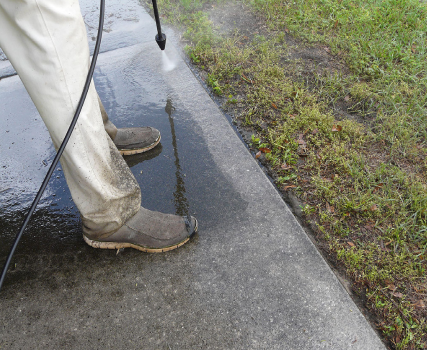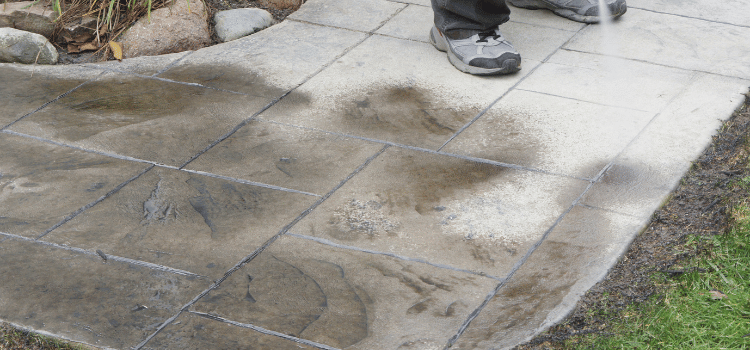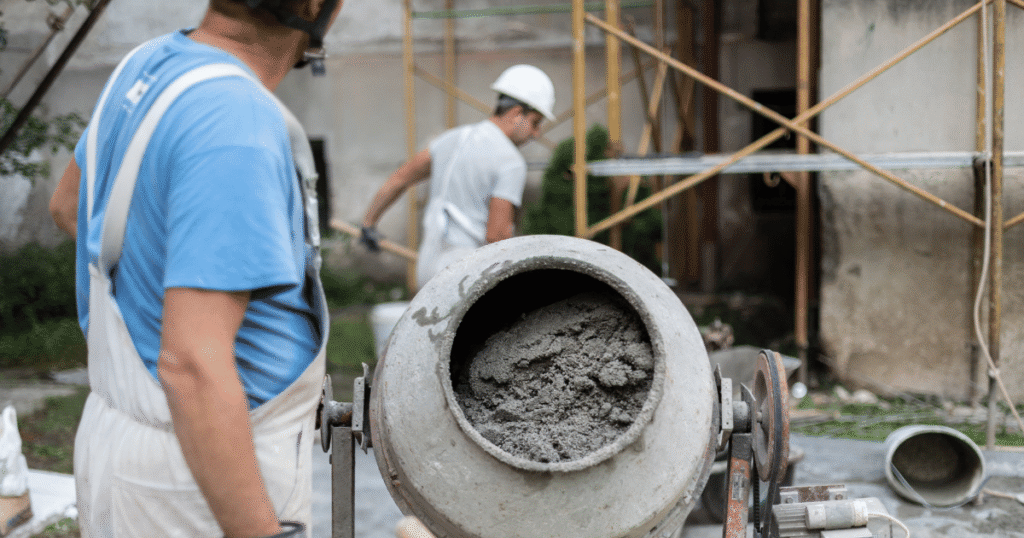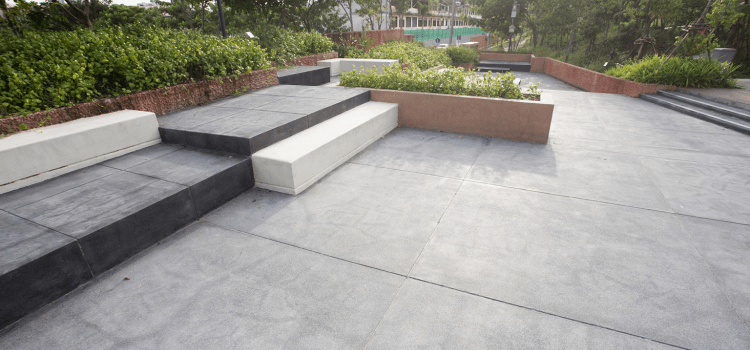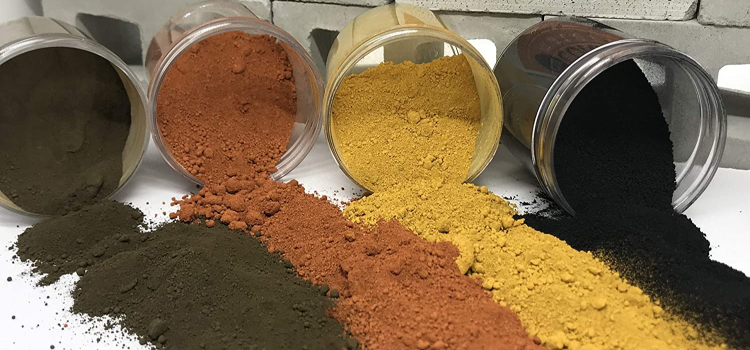What is a concrete sealer and how can it help protect your concrete?
Concrete sealant is a polyurethane or epoxy membrane that is applied to the surface of your concrete once the concrete has cured.
There are many reasons for applying a concrete sealer.
- Protect your concrete from corrosion, staining, and other forms of surface damage.
- Enhance to look and feel of your concrete
- Help prevent cracking
- Help protect colored concrete
A good concrete sealant can completely transform your existing concrete patio, driveway, footpath or other slab of concrete.
“as an Amazon Associate, I may earn from qualified purchases”
Many concrete sealants are to be applied once the concrete is completely dried ( Normally about 2 weeks ) and other concrete sealers like “same day sealer” can be applied earlier as they allow the air and moisture still in the concrete to evaporate through the sealant.
What Is A Concrete Sealer For?
There are three main reasons why you should get your concrete sealed.
The main reasons most would get their concrete sealed is to upgrade the look and feel of their concrete and to protect the lifespan of the surface and structure of the concrete.
What is a concrete sealer for?
Here are the 3 reasons to use a concrete sealer
- Makes your concrete stand out and shine like new
- Protects your concrete from harsh UV rays and other elements
- Helps prevent cracks and rapid drying.
A simple way to describe the look of sealed concrete compared to unsealed concrete, would be to imagine wet stones compared to dry stones.
Find a stone that is dry and wet half of it…this is the difference visually in sealing your concrete.
UV rays and other environmental elements can break down and eat away at your concrete’s surface, completely degrading the appearance of your concrete.
Using a concrete sealer will protect your concrete by creating a hard protective layer on the surface of the concrete.
Here is a before and after photo, showing the difference
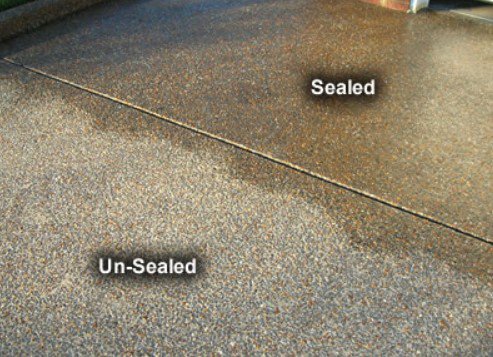
Research conducted by major concrete authorities like the American Concrete Institute, Portland Cement Association, and the National Ready Mixed Concrete Association confirms that most concrete damage is attributable to surface moisture intrusion.
The most pervasive form of concrete damage is surface scaling from freezing temperatures.
Other forms of damage include alkali-silica reaction (ASR), chemical intrusion, and corrosion of steel reinforcements
Why you should use a concrete sealer
- Protects your concrete from surface damage
- Prevents corrosion
- Stops staining
- Prolongs the color in colored concrete, stamped concrete, or other colored or dyed concrete
- Exposed concrete will shine and have that wet look, the difference is mind-blowing.
When To Use Concrete Sealer
Concrete sealer can be used on practically any concrete and is very durable.
Over the years concrete sealer has advanced in many aspects and can now withhold harsh elements that would normally degrade, damage, and eventually wreck your concrete.
The main types of concrete work a concrete sealer would be applied to would be…
Most common uses for concrete sealer
- Stamped concrete
- Exposed concrete
- Dyed concrete
- Polished concrete
- Concrete features
- Concrete with wood inlay
- Concrete pavers
- All concrete patios
Best Way To Apply Concrete Sealer
There are 3 main ways to apply concrete sealer. All ways work well and depending on the situation, certain methods may be more suited than others.
- By using a soft bristle broom: This, in my opinion is by far the fastest and easiest way to apply concrete sealer
- By paint roller or paint brush
- By using a spray unit
If you are using a broom you can just dunk the broom head in the sealer and then place it straight onto the concrete and spread back and forth with the broom.
Your concrete should be clean and dry, and if uncured properly ( Within 2 weeks of being placed ) use same-day sealant.
Same-day concrete sealer can be applied if there is still moisture in the concrete.
A good example of this is the Walttools Stampshine concrete same-day sealer.
Be sure to read the directions for each brand of sealant, there may be varients on coat thicknesses, coat dry times and placing methods.
What Is The Best Concrete Sealer?
The best concrete sealer for practically every job, and the most popular by peoples reviews is the Walttools Stampshine
Best Concrete Sealer Information
- This 25% solids, solvent-based pure acrylic resin is non-yellowing, UV resistant, anti-spill, and wear-resistant
- This “cure and seal” style sealer provides the advantage of being able to apply the day after cleaning
- Highlight all that fine detail and color from your Tru Impressions stamp job
- Coverage: approx 200 sq. ft. per gallon
Prepping Your Concrete For Concrete Sealer
If your concrete is freshly poured and has been kept clean, you are ready for concrete sealer and can start brooming, spraying, or rolling your concrete sealer onto your concrete.
If your concrete is already well used, you will need to prep your concrete in order to get maximum usage from your concrete sealer.
If you do not, and dirt, grease or grime is left on, this can cause weak spots in the concrete sealer and increases the chance of moisture breach, or in some cases, the sealant will start flaking off or discolor.
Prepping your concrete for concrete sealer
1 – Waterblast your concrete
2 – Make sure concrete is dry
3 – Broom on concrete sealer
Waterblast/pressure blast your concrete – Water blasting your concrete will ensure the dirt and grime have been removed from your concrete.
This may take some time depending on how long your concrete has been down and used for.
From personal experience prepping your concrete for concrete sealer, takes longer than applying the concrete sealer itself.
